Intellectual Property Law and Business
VerifiedAdded on 2020/01/07
|13
|4835
|230
Report
AI Summary
This assignment delves into the crucial relationship between intellectual property (IP) law and business practices. It examines how IP rights influence business models, foster innovation, and shape international commerce. Students will analyze relevant legislation, explore real-world case studies, and apply research methodologies to understand the complex implications of IP in the contemporary business environment.
Contribute Materials
Your contribution can guide someone’s learning journey. Share your
documents today.
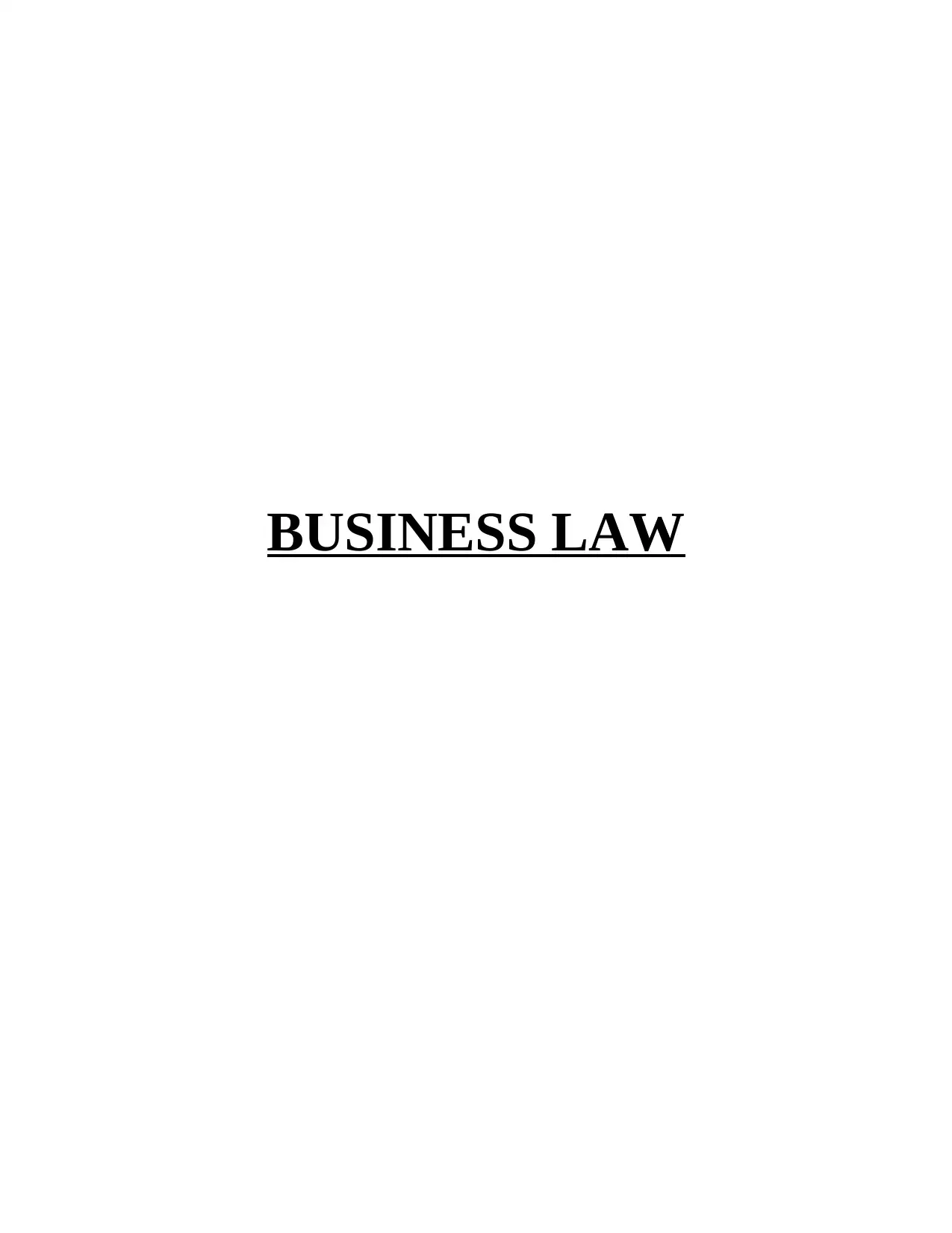
BUSINESS LAW
Secure Best Marks with AI Grader
Need help grading? Try our AI Grader for instant feedback on your assignments.
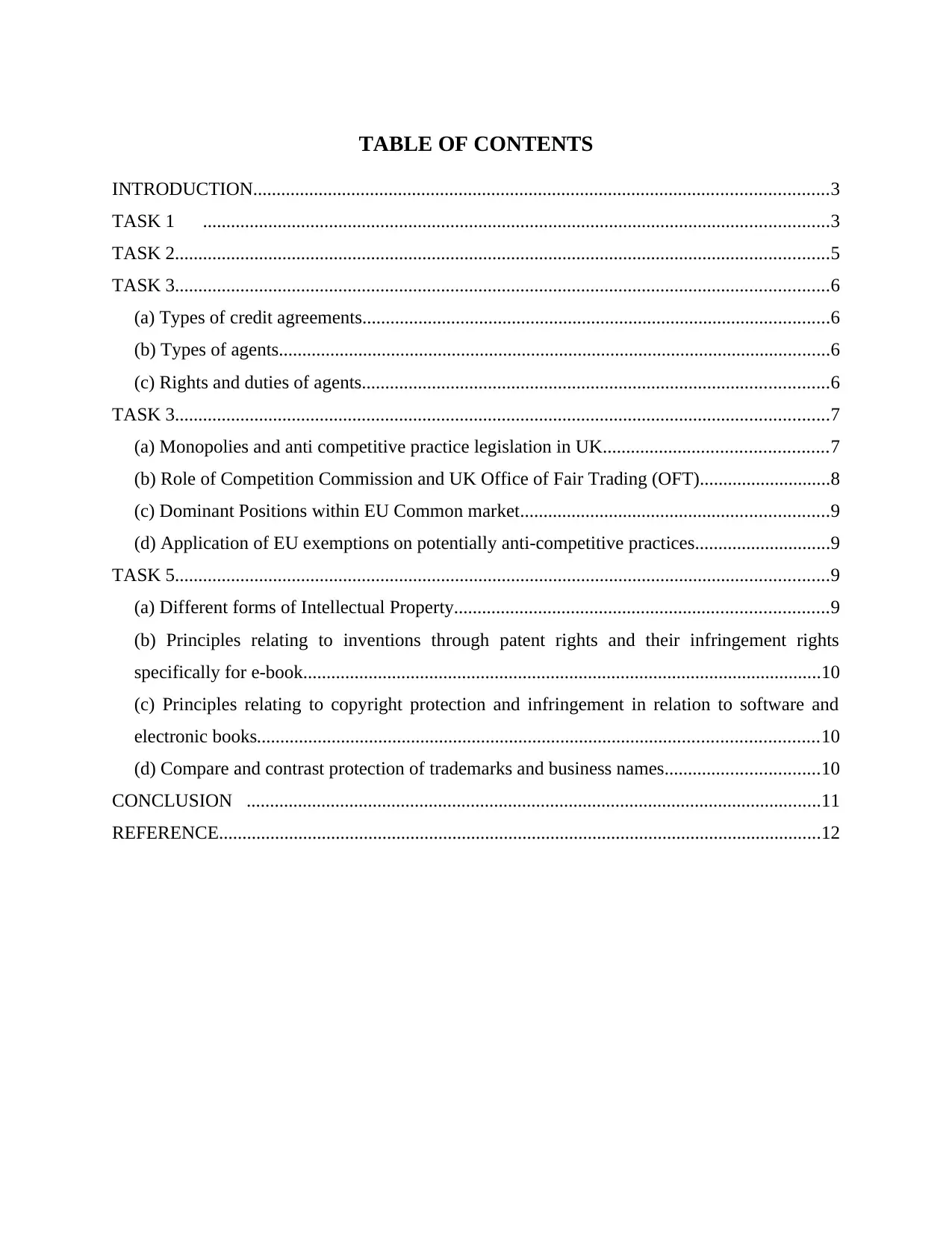
TABLE OF CONTENTS
INTRODUCTION...........................................................................................................................3
TASK 1 ......................................................................................................................................3
TASK 2............................................................................................................................................5
TASK 3............................................................................................................................................6
(a) Types of credit agreements....................................................................................................6
(b) Types of agents......................................................................................................................6
(c) Rights and duties of agents....................................................................................................6
TASK 3............................................................................................................................................7
(a) Monopolies and anti competitive practice legislation in UK................................................7
(b) Role of Competition Commission and UK Office of Fair Trading (OFT)............................8
(c) Dominant Positions within EU Common market..................................................................9
(d) Application of EU exemptions on potentially anti-competitive practices.............................9
TASK 5............................................................................................................................................9
(a) Different forms of Intellectual Property................................................................................9
(b) Principles relating to inventions through patent rights and their infringement rights
specifically for e-book...............................................................................................................10
(c) Principles relating to copyright protection and infringement in relation to software and
electronic books........................................................................................................................10
(d) Compare and contrast protection of trademarks and business names.................................10
CONCLUSION ...........................................................................................................................11
REFERENCE.................................................................................................................................12
INTRODUCTION...........................................................................................................................3
TASK 1 ......................................................................................................................................3
TASK 2............................................................................................................................................5
TASK 3............................................................................................................................................6
(a) Types of credit agreements....................................................................................................6
(b) Types of agents......................................................................................................................6
(c) Rights and duties of agents....................................................................................................6
TASK 3............................................................................................................................................7
(a) Monopolies and anti competitive practice legislation in UK................................................7
(b) Role of Competition Commission and UK Office of Fair Trading (OFT)............................8
(c) Dominant Positions within EU Common market..................................................................9
(d) Application of EU exemptions on potentially anti-competitive practices.............................9
TASK 5............................................................................................................................................9
(a) Different forms of Intellectual Property................................................................................9
(b) Principles relating to inventions through patent rights and their infringement rights
specifically for e-book...............................................................................................................10
(c) Principles relating to copyright protection and infringement in relation to software and
electronic books........................................................................................................................10
(d) Compare and contrast protection of trademarks and business names.................................10
CONCLUSION ...........................................................................................................................11
REFERENCE.................................................................................................................................12

INTRODUCTION
The Sale of goods Act, 1979 regulates the Law of Contract and the commercial law of the
nation is relation to buying and selling of products or services. This has been functioning to
provide additional protection to the buyers as well as the sellers. In other words, the provisions of
the act implicitly become a part of the contract between the two parties. The Act assure
maintenance of quality, right pricing, and suitability in all such contracts of buying and selling
(Cornish, Llewelyn and Aplin, 2013). However, the parties may expressly remove any of the
implied terms made applicable by the Act, as far as the negating terms does not fall under the
Unfair Contract Act or is not disallowed by the judiciary.
The present report shall analyze various business scenarios to understand the application
of various implied terms of the Act in relation to the supply of services, the concept of transfer
and possession of property. Further, applicable provisions of product liability shall be illustrated,
followed by which the department of consumer credit shall be evaluated on the basis of the
applicable legal rules. Finally some light shall be thrown on the aspects of Competition Law and
Intellectual Property Rights.
TASK 1
The Sale of goods Act imposes certain implied terms which may not have been included
in the contract entered into between the parties. Section 12 of the Act mandates the seller to
possess the title of the goods being sold and in a manner ensuring the delivered goods match the
requirements and the exact description of the buyers (Sale of Goods Act 1979, 2015). This has
been specifically provided for, by the Act in Section 13. In addition, Section 15 clearly provides
that the final product being delivered to the buyer shall match the samples initially shown by the
seller. The buyers under section 14 of the Act are obligated to maintain a reasonable quality of
the products or services being provided, irrespective of the fact that the contract stipulates for a
time duration or not. Similarly, even if the contract does not provide for the quality to be
The Sale of goods Act, 1979 regulates the Law of Contract and the commercial law of the
nation is relation to buying and selling of products or services. This has been functioning to
provide additional protection to the buyers as well as the sellers. In other words, the provisions of
the act implicitly become a part of the contract between the two parties. The Act assure
maintenance of quality, right pricing, and suitability in all such contracts of buying and selling
(Cornish, Llewelyn and Aplin, 2013). However, the parties may expressly remove any of the
implied terms made applicable by the Act, as far as the negating terms does not fall under the
Unfair Contract Act or is not disallowed by the judiciary.
The present report shall analyze various business scenarios to understand the application
of various implied terms of the Act in relation to the supply of services, the concept of transfer
and possession of property. Further, applicable provisions of product liability shall be illustrated,
followed by which the department of consumer credit shall be evaluated on the basis of the
applicable legal rules. Finally some light shall be thrown on the aspects of Competition Law and
Intellectual Property Rights.
TASK 1
The Sale of goods Act imposes certain implied terms which may not have been included
in the contract entered into between the parties. Section 12 of the Act mandates the seller to
possess the title of the goods being sold and in a manner ensuring the delivered goods match the
requirements and the exact description of the buyers (Sale of Goods Act 1979, 2015). This has
been specifically provided for, by the Act in Section 13. In addition, Section 15 clearly provides
that the final product being delivered to the buyer shall match the samples initially shown by the
seller. The buyers under section 14 of the Act are obligated to maintain a reasonable quality of
the products or services being provided, irrespective of the fact that the contract stipulates for a
time duration or not. Similarly, even if the contract does not provide for the quality to be

maintained, it it the duty of the seller to ensure a reasonable quality of goods or services are
being provided (May, 2013).
In the case of G and H Holmes, a new carpet of a specific colour was ordered, which was
required to be procured from outside by the Hopkins Ltd due to unavailability of the specific
product. Also, the other furniture ordered by Holmes was specifically selected by them.
However, all the selected goods were destroyed by fire, while it was in possession of the buyers.
In such a situation section 20 of the Act shall become applicable which provides for passing of
risk in the goods (Dinopoulos and Segerstrom, 2010). The section specifically says that the risk
transfers with the transfer in ownership, irrespective of the possession. However, in the event one
of the parties delay the process of delivery, the defaulting party shall be liable for the same. In
the present case, Holmes had ordered for specific products and so the ownership has been
transferred to them, but the delivery was not made by Hopkins and hence, the liability of the
destroyed goods shall fall on them. In such an event Holmes may either ask back for the advance
already paid or as for delivery of similar goods. It is important to highlight that in accordance
with section 13 and section 14 of the Act, Hopkins could not have delivered in any case.
In the case of Mr. and Mrs. Green, Easybuild provides for lowest quotation and have
earned the contract for making an extension on the Green's house. However, they undertook the
work for an extended period of time and also uses inappropriate colour of the extension, not
matching the current colour of the house. In such a situation the Green's can rely on section 14 of
the Act which mandates the service provider to provide quality goods, which fits in the purpose
for which it has been bought. In order words, it obligates the seller to provide goods which
satisfy the quality standards. The present case also attract section 14 of Supply of Goods and
Services Act, 1982 (SGSA), as Easybuild is providing the service in the form building the
extension along with the supply of material to be used for the same. Hence, on application of the
provisions, the supplier is under a duty to supply quality goods as well as carry out the services
within a reasonable time, even if the contract does not provide for any specific time. In addition,
in accordance to section 15 of SGSA, even if the contract does not provide for a specific price,
the seller is required to charge reasonably, which shall completely depend on the circumstances
of the case (Williams, 2010.). Identical facts were put before the court in the case of Stevenson v.
Rogers (1999), where the court opined that 'satisfactory quality' can be judged on the basis of
standard of a reasonable man. It was further observed that in the event the quality or the manner
being provided (May, 2013).
In the case of G and H Holmes, a new carpet of a specific colour was ordered, which was
required to be procured from outside by the Hopkins Ltd due to unavailability of the specific
product. Also, the other furniture ordered by Holmes was specifically selected by them.
However, all the selected goods were destroyed by fire, while it was in possession of the buyers.
In such a situation section 20 of the Act shall become applicable which provides for passing of
risk in the goods (Dinopoulos and Segerstrom, 2010). The section specifically says that the risk
transfers with the transfer in ownership, irrespective of the possession. However, in the event one
of the parties delay the process of delivery, the defaulting party shall be liable for the same. In
the present case, Holmes had ordered for specific products and so the ownership has been
transferred to them, but the delivery was not made by Hopkins and hence, the liability of the
destroyed goods shall fall on them. In such an event Holmes may either ask back for the advance
already paid or as for delivery of similar goods. It is important to highlight that in accordance
with section 13 and section 14 of the Act, Hopkins could not have delivered in any case.
In the case of Mr. and Mrs. Green, Easybuild provides for lowest quotation and have
earned the contract for making an extension on the Green's house. However, they undertook the
work for an extended period of time and also uses inappropriate colour of the extension, not
matching the current colour of the house. In such a situation the Green's can rely on section 14 of
the Act which mandates the service provider to provide quality goods, which fits in the purpose
for which it has been bought. In order words, it obligates the seller to provide goods which
satisfy the quality standards. The present case also attract section 14 of Supply of Goods and
Services Act, 1982 (SGSA), as Easybuild is providing the service in the form building the
extension along with the supply of material to be used for the same. Hence, on application of the
provisions, the supplier is under a duty to supply quality goods as well as carry out the services
within a reasonable time, even if the contract does not provide for any specific time. In addition,
in accordance to section 15 of SGSA, even if the contract does not provide for a specific price,
the seller is required to charge reasonably, which shall completely depend on the circumstances
of the case (Williams, 2010.). Identical facts were put before the court in the case of Stevenson v.
Rogers (1999), where the court opined that 'satisfactory quality' can be judged on the basis of
standard of a reasonable man. It was further observed that in the event the quality or the manner
Secure Best Marks with AI Grader
Need help grading? Try our AI Grader for instant feedback on your assignments.
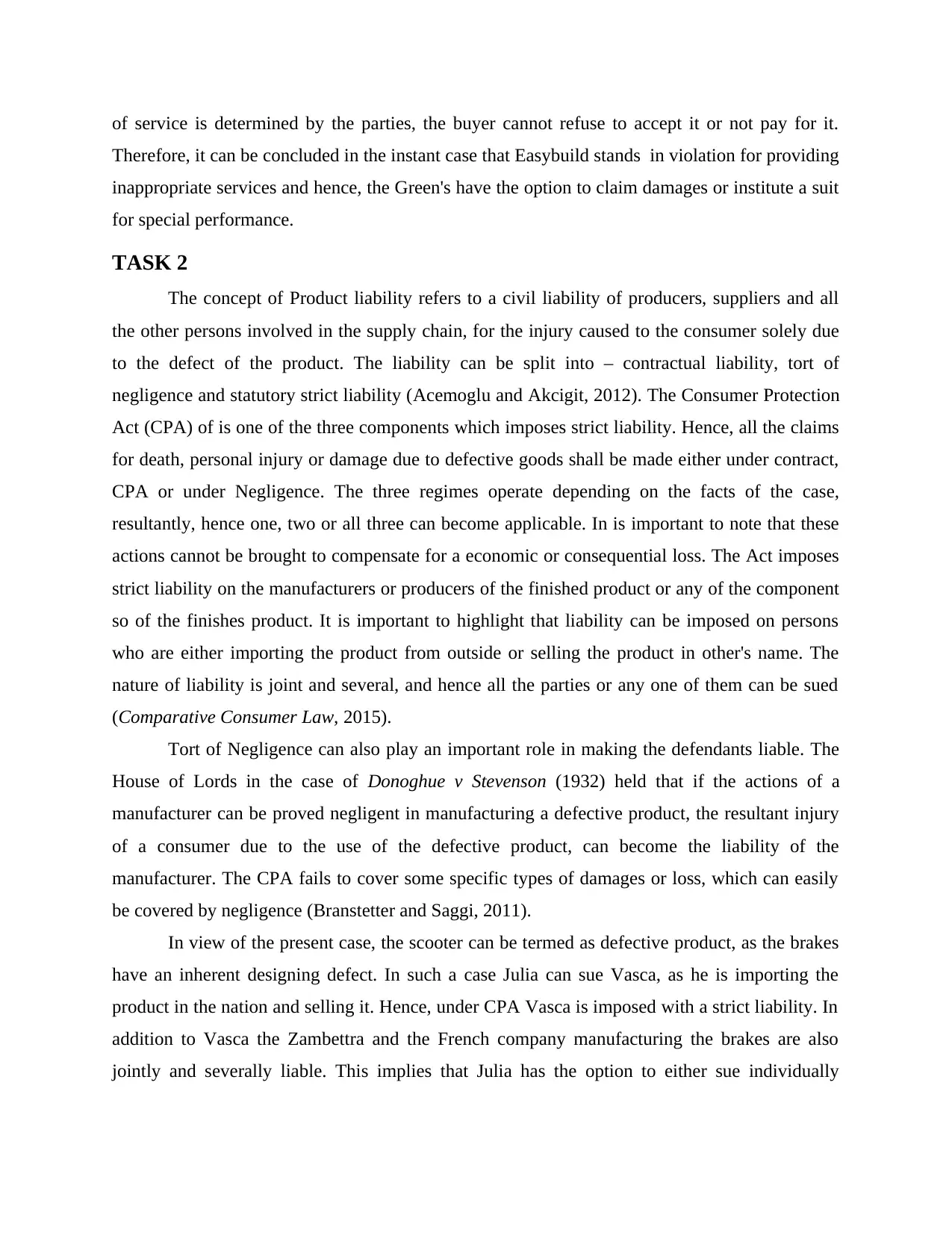
of service is determined by the parties, the buyer cannot refuse to accept it or not pay for it.
Therefore, it can be concluded in the instant case that Easybuild stands in violation for providing
inappropriate services and hence, the Green's have the option to claim damages or institute a suit
for special performance.
TASK 2
The concept of Product liability refers to a civil liability of producers, suppliers and all
the other persons involved in the supply chain, for the injury caused to the consumer solely due
to the defect of the product. The liability can be split into – contractual liability, tort of
negligence and statutory strict liability (Acemoglu and Akcigit, 2012). The Consumer Protection
Act (CPA) of is one of the three components which imposes strict liability. Hence, all the claims
for death, personal injury or damage due to defective goods shall be made either under contract,
CPA or under Negligence. The three regimes operate depending on the facts of the case,
resultantly, hence one, two or all three can become applicable. In is important to note that these
actions cannot be brought to compensate for a economic or consequential loss. The Act imposes
strict liability on the manufacturers or producers of the finished product or any of the component
so of the finishes product. It is important to highlight that liability can be imposed on persons
who are either importing the product from outside or selling the product in other's name. The
nature of liability is joint and several, and hence all the parties or any one of them can be sued
(Comparative Consumer Law, 2015).
Tort of Negligence can also play an important role in making the defendants liable. The
House of Lords in the case of Donoghue v Stevenson (1932) held that if the actions of a
manufacturer can be proved negligent in manufacturing a defective product, the resultant injury
of a consumer due to the use of the defective product, can become the liability of the
manufacturer. The CPA fails to cover some specific types of damages or loss, which can easily
be covered by negligence (Branstetter and Saggi, 2011).
In view of the present case, the scooter can be termed as defective product, as the brakes
have an inherent designing defect. In such a case Julia can sue Vasca, as he is importing the
product in the nation and selling it. Hence, under CPA Vasca is imposed with a strict liability. In
addition to Vasca the Zambettra and the French company manufacturing the brakes are also
jointly and severally liable. This implies that Julia has the option to either sue individually
Therefore, it can be concluded in the instant case that Easybuild stands in violation for providing
inappropriate services and hence, the Green's have the option to claim damages or institute a suit
for special performance.
TASK 2
The concept of Product liability refers to a civil liability of producers, suppliers and all
the other persons involved in the supply chain, for the injury caused to the consumer solely due
to the defect of the product. The liability can be split into – contractual liability, tort of
negligence and statutory strict liability (Acemoglu and Akcigit, 2012). The Consumer Protection
Act (CPA) of is one of the three components which imposes strict liability. Hence, all the claims
for death, personal injury or damage due to defective goods shall be made either under contract,
CPA or under Negligence. The three regimes operate depending on the facts of the case,
resultantly, hence one, two or all three can become applicable. In is important to note that these
actions cannot be brought to compensate for a economic or consequential loss. The Act imposes
strict liability on the manufacturers or producers of the finished product or any of the component
so of the finishes product. It is important to highlight that liability can be imposed on persons
who are either importing the product from outside or selling the product in other's name. The
nature of liability is joint and several, and hence all the parties or any one of them can be sued
(Comparative Consumer Law, 2015).
Tort of Negligence can also play an important role in making the defendants liable. The
House of Lords in the case of Donoghue v Stevenson (1932) held that if the actions of a
manufacturer can be proved negligent in manufacturing a defective product, the resultant injury
of a consumer due to the use of the defective product, can become the liability of the
manufacturer. The CPA fails to cover some specific types of damages or loss, which can easily
be covered by negligence (Branstetter and Saggi, 2011).
In view of the present case, the scooter can be termed as defective product, as the brakes
have an inherent designing defect. In such a case Julia can sue Vasca, as he is importing the
product in the nation and selling it. Hence, under CPA Vasca is imposed with a strict liability. In
addition to Vasca the Zambettra and the French company manufacturing the brakes are also
jointly and severally liable. This implies that Julia has the option to either sue individually
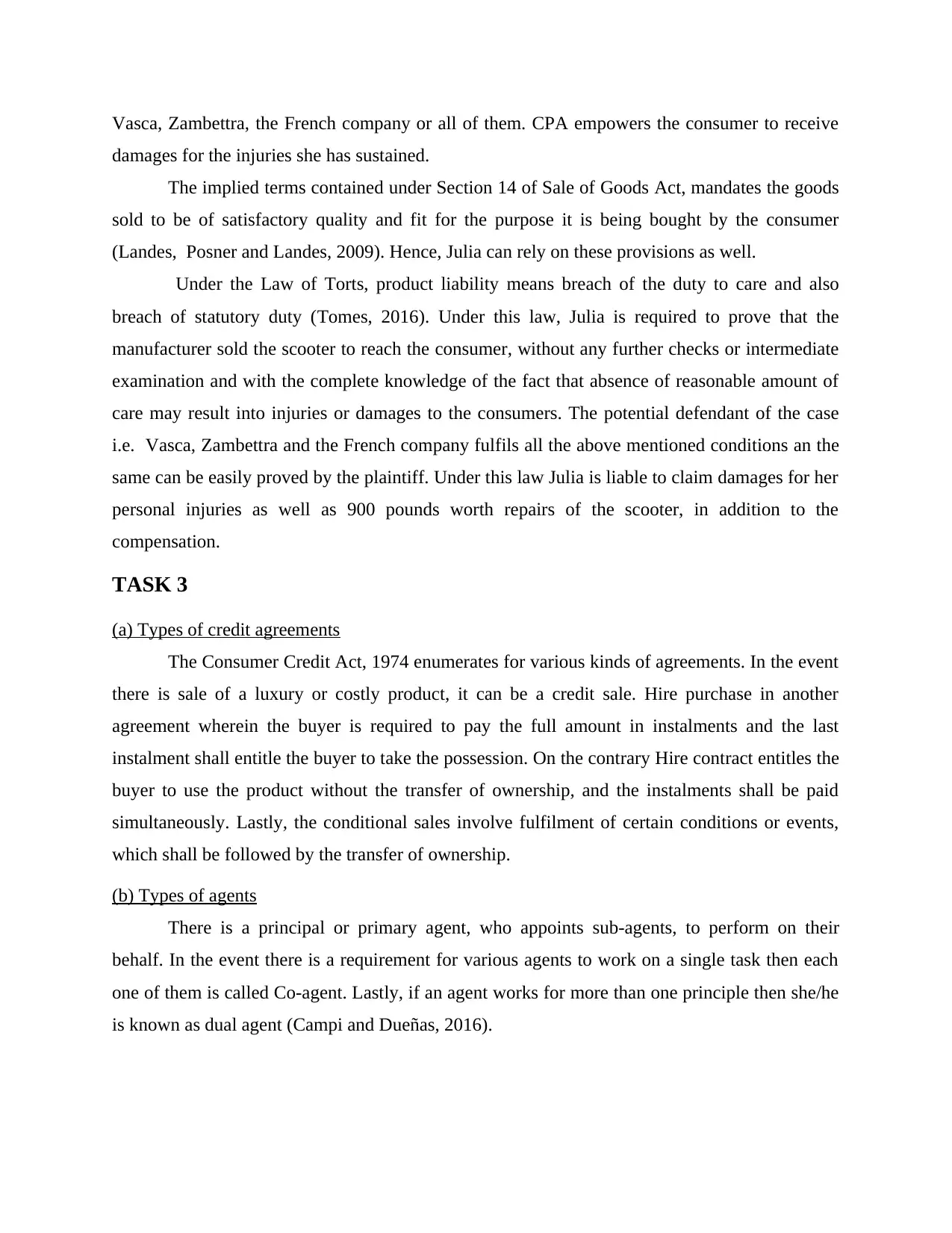
Vasca, Zambettra, the French company or all of them. CPA empowers the consumer to receive
damages for the injuries she has sustained.
The implied terms contained under Section 14 of Sale of Goods Act, mandates the goods
sold to be of satisfactory quality and fit for the purpose it is being bought by the consumer
(Landes, Posner and Landes, 2009). Hence, Julia can rely on these provisions as well.
Under the Law of Torts, product liability means breach of the duty to care and also
breach of statutory duty (Tomes, 2016). Under this law, Julia is required to prove that the
manufacturer sold the scooter to reach the consumer, without any further checks or intermediate
examination and with the complete knowledge of the fact that absence of reasonable amount of
care may result into injuries or damages to the consumers. The potential defendant of the case
i.e. Vasca, Zambettra and the French company fulfils all the above mentioned conditions an the
same can be easily proved by the plaintiff. Under this law Julia is liable to claim damages for her
personal injuries as well as 900 pounds worth repairs of the scooter, in addition to the
compensation.
TASK 3
(a) Types of credit agreements
The Consumer Credit Act, 1974 enumerates for various kinds of agreements. In the event
there is sale of a luxury or costly product, it can be a credit sale. Hire purchase in another
agreement wherein the buyer is required to pay the full amount in instalments and the last
instalment shall entitle the buyer to take the possession. On the contrary Hire contract entitles the
buyer to use the product without the transfer of ownership, and the instalments shall be paid
simultaneously. Lastly, the conditional sales involve fulfilment of certain conditions or events,
which shall be followed by the transfer of ownership.
(b) Types of agents
There is a principal or primary agent, who appoints sub-agents, to perform on their
behalf. In the event there is a requirement for various agents to work on a single task then each
one of them is called Co-agent. Lastly, if an agent works for more than one principle then she/he
is known as dual agent (Campi and Dueñas, 2016).
damages for the injuries she has sustained.
The implied terms contained under Section 14 of Sale of Goods Act, mandates the goods
sold to be of satisfactory quality and fit for the purpose it is being bought by the consumer
(Landes, Posner and Landes, 2009). Hence, Julia can rely on these provisions as well.
Under the Law of Torts, product liability means breach of the duty to care and also
breach of statutory duty (Tomes, 2016). Under this law, Julia is required to prove that the
manufacturer sold the scooter to reach the consumer, without any further checks or intermediate
examination and with the complete knowledge of the fact that absence of reasonable amount of
care may result into injuries or damages to the consumers. The potential defendant of the case
i.e. Vasca, Zambettra and the French company fulfils all the above mentioned conditions an the
same can be easily proved by the plaintiff. Under this law Julia is liable to claim damages for her
personal injuries as well as 900 pounds worth repairs of the scooter, in addition to the
compensation.
TASK 3
(a) Types of credit agreements
The Consumer Credit Act, 1974 enumerates for various kinds of agreements. In the event
there is sale of a luxury or costly product, it can be a credit sale. Hire purchase in another
agreement wherein the buyer is required to pay the full amount in instalments and the last
instalment shall entitle the buyer to take the possession. On the contrary Hire contract entitles the
buyer to use the product without the transfer of ownership, and the instalments shall be paid
simultaneously. Lastly, the conditional sales involve fulfilment of certain conditions or events,
which shall be followed by the transfer of ownership.
(b) Types of agents
There is a principal or primary agent, who appoints sub-agents, to perform on their
behalf. In the event there is a requirement for various agents to work on a single task then each
one of them is called Co-agent. Lastly, if an agent works for more than one principle then she/he
is known as dual agent (Campi and Dueñas, 2016).

(c) Rights and duties of agents
The rights and duties of agents may vary from being express or implied agent. In the
former case the principal hires an agent to act on his behalf and is imposed with the duty to act in
accordance to his orders. In the latter case, the agent is required to adhere to the implied orders of
the person for whom he is acting. In both the cases, the agents have the right to reimburse all the
expenses while acting on behalf of the principal.
In the present case the parties have entered into a Hire-purchase agreement. In the event,
the creditor wishes to enforce the agreement, a default notice shall be necessarily served on the
debtor in his/her name. The default notice shall be is in compliance to section 88 (2) of the Act.
Section 87 of the Act enlists certain activities which require prior serving of the default notice.
One of the activities enlisted in this section is that of termination of the agreement (Consumer
Credit Act default notices, 2016).
In the (a) case, the customer pays three instalments and fails to pay the forth one, the
customer shall be required to hand over the hired product to the company as less than one-third
payments have been made. Hence, the company shall repossess the product so hired. In addition,
the customer may not be entitled to receive the amounts already paid and further, may have to
face legal consequences.
In the (b) case, if the fifth and sixth have become due, in addition to above mentioned
liabilities of the customers, he/she shall be required to pay defaulting interest on the instalments
becoming due.
In the (c) case, if the goods purchased have been damaged while in possession of the
customer, the customer shall be required to pay all the instalments, provided it is proved that
damage happened due to the customers.
If the customer does not terminate the agreement but stops payment of the instalments,
the company shall be required to serve the default notice to the debtor, specifically in compliance
with section 88(2) of the Act. It shall also provide for a period of 14 days for recovery of the
payments or the arrears, failure to which the company shall be entitled to repossess the goods ad
terminate the contract.
The rights and duties of agents may vary from being express or implied agent. In the
former case the principal hires an agent to act on his behalf and is imposed with the duty to act in
accordance to his orders. In the latter case, the agent is required to adhere to the implied orders of
the person for whom he is acting. In both the cases, the agents have the right to reimburse all the
expenses while acting on behalf of the principal.
In the present case the parties have entered into a Hire-purchase agreement. In the event,
the creditor wishes to enforce the agreement, a default notice shall be necessarily served on the
debtor in his/her name. The default notice shall be is in compliance to section 88 (2) of the Act.
Section 87 of the Act enlists certain activities which require prior serving of the default notice.
One of the activities enlisted in this section is that of termination of the agreement (Consumer
Credit Act default notices, 2016).
In the (a) case, the customer pays three instalments and fails to pay the forth one, the
customer shall be required to hand over the hired product to the company as less than one-third
payments have been made. Hence, the company shall repossess the product so hired. In addition,
the customer may not be entitled to receive the amounts already paid and further, may have to
face legal consequences.
In the (b) case, if the fifth and sixth have become due, in addition to above mentioned
liabilities of the customers, he/she shall be required to pay defaulting interest on the instalments
becoming due.
In the (c) case, if the goods purchased have been damaged while in possession of the
customer, the customer shall be required to pay all the instalments, provided it is proved that
damage happened due to the customers.
If the customer does not terminate the agreement but stops payment of the instalments,
the company shall be required to serve the default notice to the debtor, specifically in compliance
with section 88(2) of the Act. It shall also provide for a period of 14 days for recovery of the
payments or the arrears, failure to which the company shall be entitled to repossess the goods ad
terminate the contract.
Paraphrase This Document
Need a fresh take? Get an instant paraphrase of this document with our AI Paraphraser
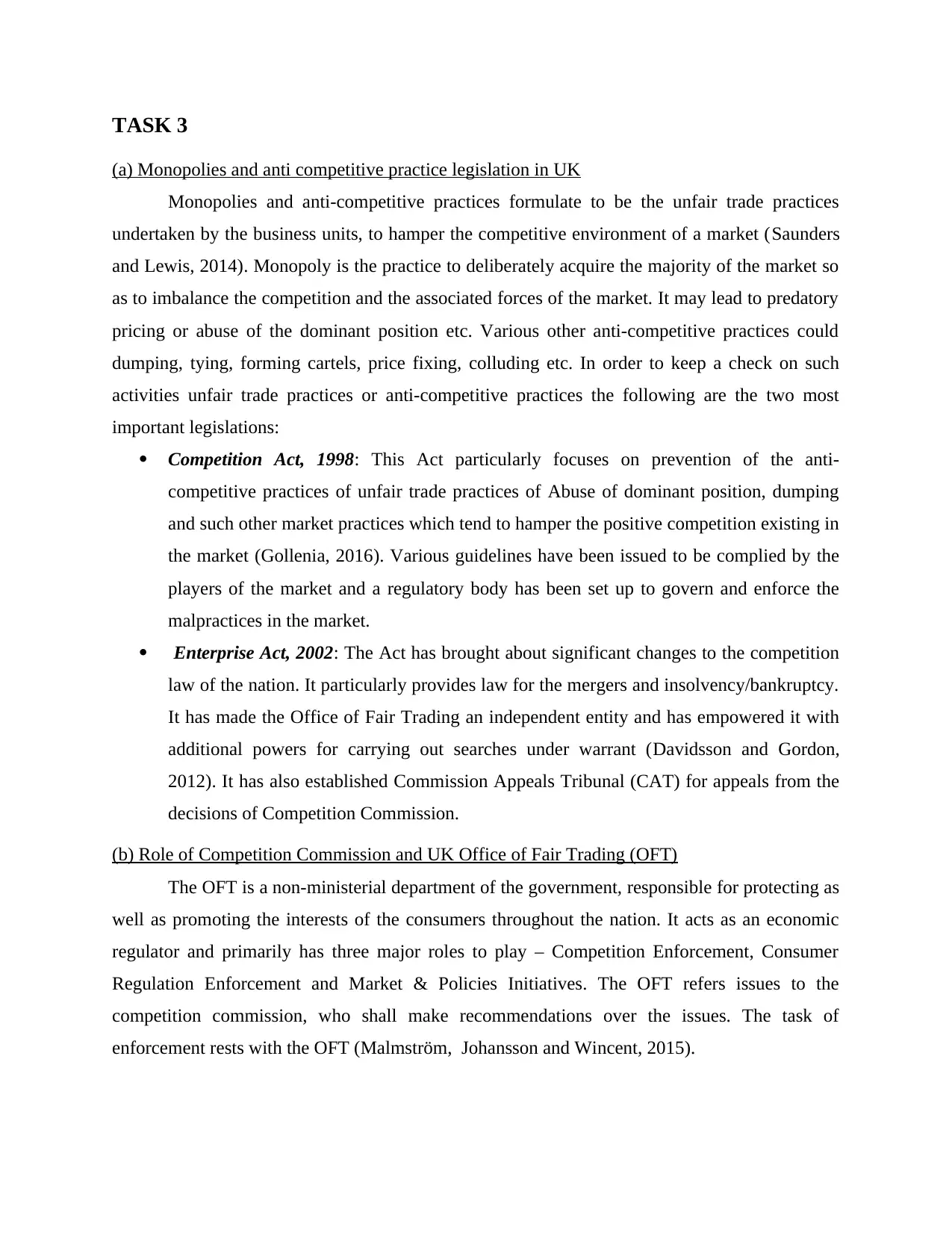
TASK 3
(a) Monopolies and anti competitive practice legislation in UK
Monopolies and anti-competitive practices formulate to be the unfair trade practices
undertaken by the business units, to hamper the competitive environment of a market (Saunders
and Lewis, 2014). Monopoly is the practice to deliberately acquire the majority of the market so
as to imbalance the competition and the associated forces of the market. It may lead to predatory
pricing or abuse of the dominant position etc. Various other anti-competitive practices could
dumping, tying, forming cartels, price fixing, colluding etc. In order to keep a check on such
activities unfair trade practices or anti-competitive practices the following are the two most
important legislations:
Competition Act, 1998: This Act particularly focuses on prevention of the anti-
competitive practices of unfair trade practices of Abuse of dominant position, dumping
and such other market practices which tend to hamper the positive competition existing in
the market (Gollenia, 2016). Various guidelines have been issued to be complied by the
players of the market and a regulatory body has been set up to govern and enforce the
malpractices in the market.
Enterprise Act, 2002: The Act has brought about significant changes to the competition
law of the nation. It particularly provides law for the mergers and insolvency/bankruptcy.
It has made the Office of Fair Trading an independent entity and has empowered it with
additional powers for carrying out searches under warrant (Davidsson and Gordon,
2012). It has also established Commission Appeals Tribunal (CAT) for appeals from the
decisions of Competition Commission.
(b) Role of Competition Commission and UK Office of Fair Trading (OFT)
The OFT is a non-ministerial department of the government, responsible for protecting as
well as promoting the interests of the consumers throughout the nation. It acts as an economic
regulator and primarily has three major roles to play – Competition Enforcement, Consumer
Regulation Enforcement and Market & Policies Initiatives. The OFT refers issues to the
competition commission, who shall make recommendations over the issues. The task of
enforcement rests with the OFT (Malmström, Johansson and Wincent, 2015).
(a) Monopolies and anti competitive practice legislation in UK
Monopolies and anti-competitive practices formulate to be the unfair trade practices
undertaken by the business units, to hamper the competitive environment of a market (Saunders
and Lewis, 2014). Monopoly is the practice to deliberately acquire the majority of the market so
as to imbalance the competition and the associated forces of the market. It may lead to predatory
pricing or abuse of the dominant position etc. Various other anti-competitive practices could
dumping, tying, forming cartels, price fixing, colluding etc. In order to keep a check on such
activities unfair trade practices or anti-competitive practices the following are the two most
important legislations:
Competition Act, 1998: This Act particularly focuses on prevention of the anti-
competitive practices of unfair trade practices of Abuse of dominant position, dumping
and such other market practices which tend to hamper the positive competition existing in
the market (Gollenia, 2016). Various guidelines have been issued to be complied by the
players of the market and a regulatory body has been set up to govern and enforce the
malpractices in the market.
Enterprise Act, 2002: The Act has brought about significant changes to the competition
law of the nation. It particularly provides law for the mergers and insolvency/bankruptcy.
It has made the Office of Fair Trading an independent entity and has empowered it with
additional powers for carrying out searches under warrant (Davidsson and Gordon,
2012). It has also established Commission Appeals Tribunal (CAT) for appeals from the
decisions of Competition Commission.
(b) Role of Competition Commission and UK Office of Fair Trading (OFT)
The OFT is a non-ministerial department of the government, responsible for protecting as
well as promoting the interests of the consumers throughout the nation. It acts as an economic
regulator and primarily has three major roles to play – Competition Enforcement, Consumer
Regulation Enforcement and Market & Policies Initiatives. The OFT refers issues to the
competition commission, who shall make recommendations over the issues. The task of
enforcement rests with the OFT (Malmström, Johansson and Wincent, 2015).
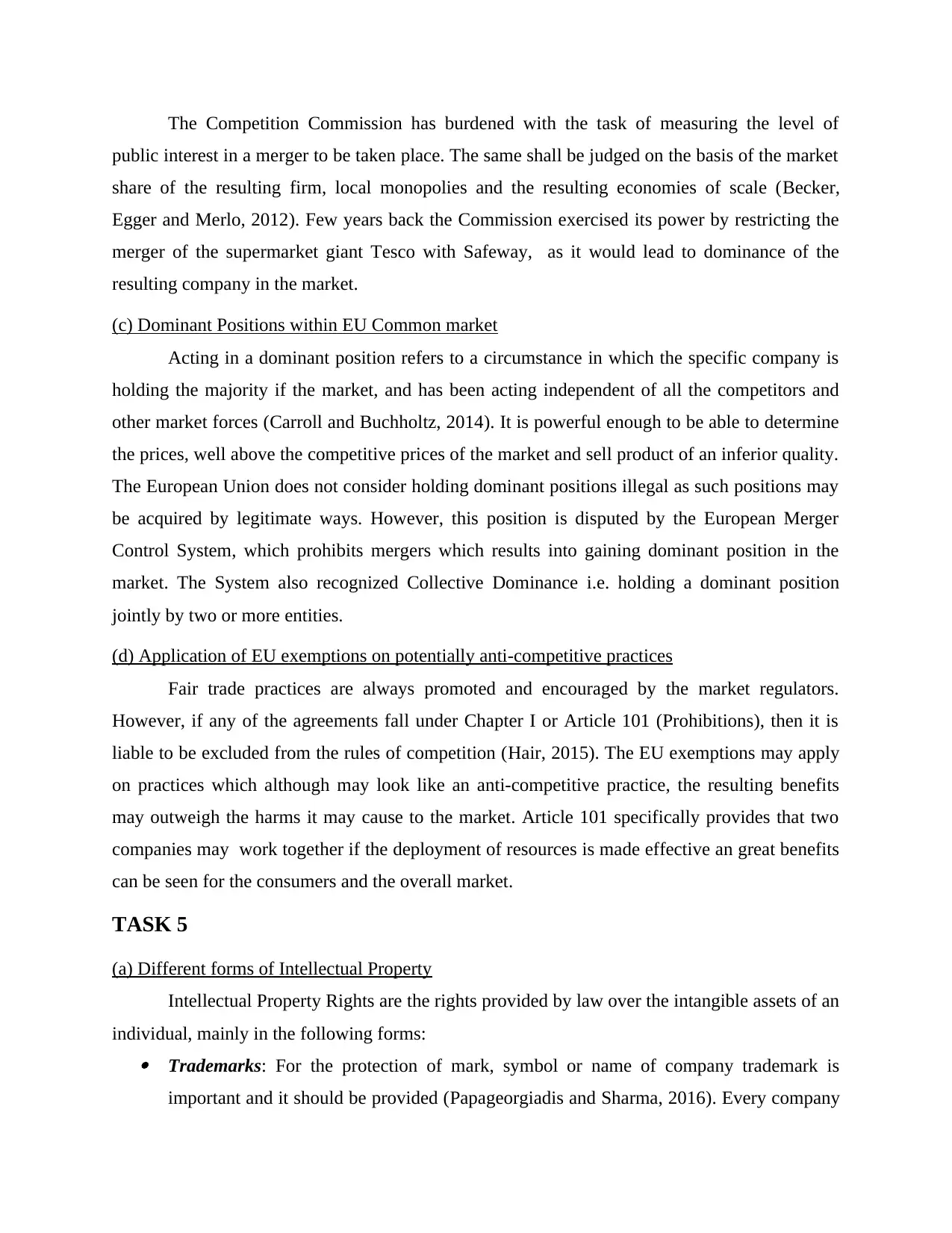
The Competition Commission has burdened with the task of measuring the level of
public interest in a merger to be taken place. The same shall be judged on the basis of the market
share of the resulting firm, local monopolies and the resulting economies of scale (Becker,
Egger and Merlo, 2012). Few years back the Commission exercised its power by restricting the
merger of the supermarket giant Tesco with Safeway, as it would lead to dominance of the
resulting company in the market.
(c) Dominant Positions within EU Common market
Acting in a dominant position refers to a circumstance in which the specific company is
holding the majority if the market, and has been acting independent of all the competitors and
other market forces (Carroll and Buchholtz, 2014). It is powerful enough to be able to determine
the prices, well above the competitive prices of the market and sell product of an inferior quality.
The European Union does not consider holding dominant positions illegal as such positions may
be acquired by legitimate ways. However, this position is disputed by the European Merger
Control System, which prohibits mergers which results into gaining dominant position in the
market. The System also recognized Collective Dominance i.e. holding a dominant position
jointly by two or more entities.
(d) Application of EU exemptions on potentially anti-competitive practices
Fair trade practices are always promoted and encouraged by the market regulators.
However, if any of the agreements fall under Chapter I or Article 101 (Prohibitions), then it is
liable to be excluded from the rules of competition (Hair, 2015). The EU exemptions may apply
on practices which although may look like an anti-competitive practice, the resulting benefits
may outweigh the harms it may cause to the market. Article 101 specifically provides that two
companies may work together if the deployment of resources is made effective an great benefits
can be seen for the consumers and the overall market.
TASK 5
(a) Different forms of Intellectual Property
Intellectual Property Rights are the rights provided by law over the intangible assets of an
individual, mainly in the following forms: Trademarks: For the protection of mark, symbol or name of company trademark is
important and it should be provided (Papageorgiadis and Sharma, 2016). Every company
public interest in a merger to be taken place. The same shall be judged on the basis of the market
share of the resulting firm, local monopolies and the resulting economies of scale (Becker,
Egger and Merlo, 2012). Few years back the Commission exercised its power by restricting the
merger of the supermarket giant Tesco with Safeway, as it would lead to dominance of the
resulting company in the market.
(c) Dominant Positions within EU Common market
Acting in a dominant position refers to a circumstance in which the specific company is
holding the majority if the market, and has been acting independent of all the competitors and
other market forces (Carroll and Buchholtz, 2014). It is powerful enough to be able to determine
the prices, well above the competitive prices of the market and sell product of an inferior quality.
The European Union does not consider holding dominant positions illegal as such positions may
be acquired by legitimate ways. However, this position is disputed by the European Merger
Control System, which prohibits mergers which results into gaining dominant position in the
market. The System also recognized Collective Dominance i.e. holding a dominant position
jointly by two or more entities.
(d) Application of EU exemptions on potentially anti-competitive practices
Fair trade practices are always promoted and encouraged by the market regulators.
However, if any of the agreements fall under Chapter I or Article 101 (Prohibitions), then it is
liable to be excluded from the rules of competition (Hair, 2015). The EU exemptions may apply
on practices which although may look like an anti-competitive practice, the resulting benefits
may outweigh the harms it may cause to the market. Article 101 specifically provides that two
companies may work together if the deployment of resources is made effective an great benefits
can be seen for the consumers and the overall market.
TASK 5
(a) Different forms of Intellectual Property
Intellectual Property Rights are the rights provided by law over the intangible assets of an
individual, mainly in the following forms: Trademarks: For the protection of mark, symbol or name of company trademark is
important and it should be provided (Papageorgiadis and Sharma, 2016). Every company
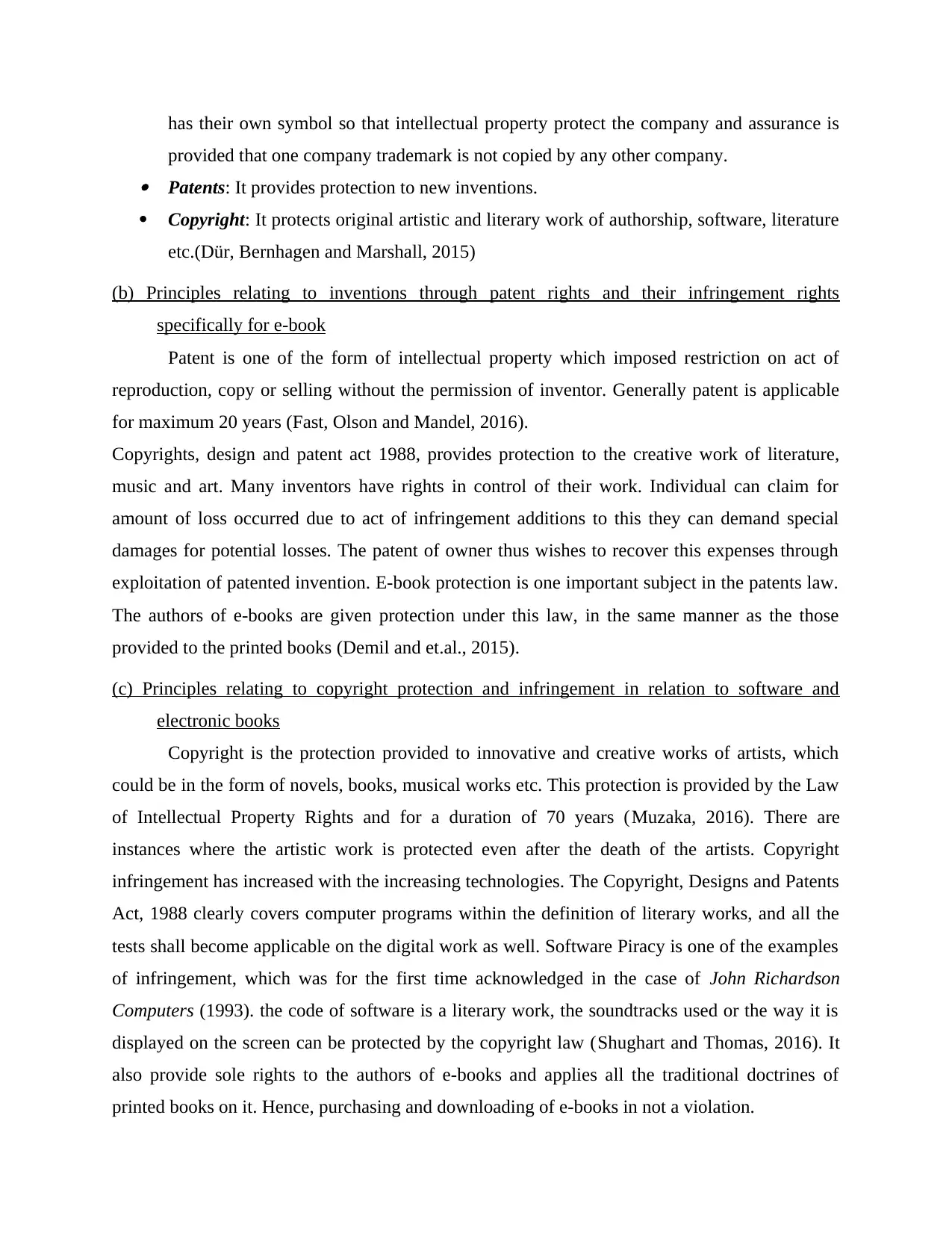
has their own symbol so that intellectual property protect the company and assurance is
provided that one company trademark is not copied by any other company. Patents: It provides protection to new inventions.
Copyright: It protects original artistic and literary work of authorship, software, literature
etc.(Dür, Bernhagen and Marshall, 2015)
(b) Principles relating to inventions through patent rights and their infringement rights
specifically for e-book
Patent is one of the form of intellectual property which imposed restriction on act of
reproduction, copy or selling without the permission of inventor. Generally patent is applicable
for maximum 20 years (Fast, Olson and Mandel, 2016).
Copyrights, design and patent act 1988, provides protection to the creative work of literature,
music and art. Many inventors have rights in control of their work. Individual can claim for
amount of loss occurred due to act of infringement additions to this they can demand special
damages for potential losses. The patent of owner thus wishes to recover this expenses through
exploitation of patented invention. E-book protection is one important subject in the patents law.
The authors of e-books are given protection under this law, in the same manner as the those
provided to the printed books (Demil and et.al., 2015).
(c) Principles relating to copyright protection and infringement in relation to software and
electronic books
Copyright is the protection provided to innovative and creative works of artists, which
could be in the form of novels, books, musical works etc. This protection is provided by the Law
of Intellectual Property Rights and for a duration of 70 years (Muzaka, 2016). There are
instances where the artistic work is protected even after the death of the artists. Copyright
infringement has increased with the increasing technologies. The Copyright, Designs and Patents
Act, 1988 clearly covers computer programs within the definition of literary works, and all the
tests shall become applicable on the digital work as well. Software Piracy is one of the examples
of infringement, which was for the first time acknowledged in the case of John Richardson
Computers (1993). the code of software is a literary work, the soundtracks used or the way it is
displayed on the screen can be protected by the copyright law (Shughart and Thomas, 2016). It
also provide sole rights to the authors of e-books and applies all the traditional doctrines of
printed books on it. Hence, purchasing and downloading of e-books in not a violation.
provided that one company trademark is not copied by any other company. Patents: It provides protection to new inventions.
Copyright: It protects original artistic and literary work of authorship, software, literature
etc.(Dür, Bernhagen and Marshall, 2015)
(b) Principles relating to inventions through patent rights and their infringement rights
specifically for e-book
Patent is one of the form of intellectual property which imposed restriction on act of
reproduction, copy or selling without the permission of inventor. Generally patent is applicable
for maximum 20 years (Fast, Olson and Mandel, 2016).
Copyrights, design and patent act 1988, provides protection to the creative work of literature,
music and art. Many inventors have rights in control of their work. Individual can claim for
amount of loss occurred due to act of infringement additions to this they can demand special
damages for potential losses. The patent of owner thus wishes to recover this expenses through
exploitation of patented invention. E-book protection is one important subject in the patents law.
The authors of e-books are given protection under this law, in the same manner as the those
provided to the printed books (Demil and et.al., 2015).
(c) Principles relating to copyright protection and infringement in relation to software and
electronic books
Copyright is the protection provided to innovative and creative works of artists, which
could be in the form of novels, books, musical works etc. This protection is provided by the Law
of Intellectual Property Rights and for a duration of 70 years (Muzaka, 2016). There are
instances where the artistic work is protected even after the death of the artists. Copyright
infringement has increased with the increasing technologies. The Copyright, Designs and Patents
Act, 1988 clearly covers computer programs within the definition of literary works, and all the
tests shall become applicable on the digital work as well. Software Piracy is one of the examples
of infringement, which was for the first time acknowledged in the case of John Richardson
Computers (1993). the code of software is a literary work, the soundtracks used or the way it is
displayed on the screen can be protected by the copyright law (Shughart and Thomas, 2016). It
also provide sole rights to the authors of e-books and applies all the traditional doctrines of
printed books on it. Hence, purchasing and downloading of e-books in not a violation.
Secure Best Marks with AI Grader
Need help grading? Try our AI Grader for instant feedback on your assignments.
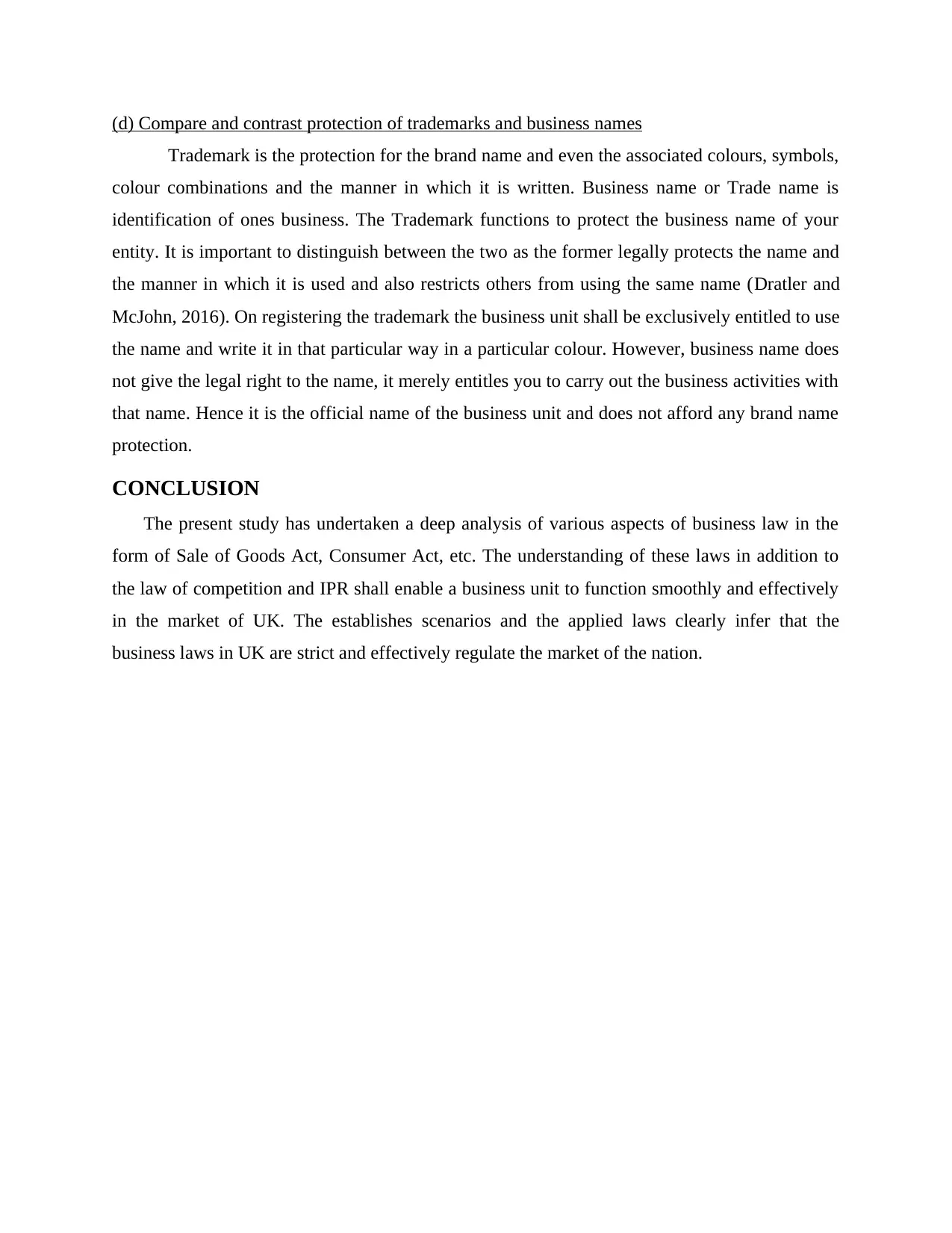
(d) Compare and contrast protection of trademarks and business names
Trademark is the protection for the brand name and even the associated colours, symbols,
colour combinations and the manner in which it is written. Business name or Trade name is
identification of ones business. The Trademark functions to protect the business name of your
entity. It is important to distinguish between the two as the former legally protects the name and
the manner in which it is used and also restricts others from using the same name (Dratler and
McJohn, 2016). On registering the trademark the business unit shall be exclusively entitled to use
the name and write it in that particular way in a particular colour. However, business name does
not give the legal right to the name, it merely entitles you to carry out the business activities with
that name. Hence it is the official name of the business unit and does not afford any brand name
protection.
CONCLUSION
The present study has undertaken a deep analysis of various aspects of business law in the
form of Sale of Goods Act, Consumer Act, etc. The understanding of these laws in addition to
the law of competition and IPR shall enable a business unit to function smoothly and effectively
in the market of UK. The establishes scenarios and the applied laws clearly infer that the
business laws in UK are strict and effectively regulate the market of the nation.
Trademark is the protection for the brand name and even the associated colours, symbols,
colour combinations and the manner in which it is written. Business name or Trade name is
identification of ones business. The Trademark functions to protect the business name of your
entity. It is important to distinguish between the two as the former legally protects the name and
the manner in which it is used and also restricts others from using the same name (Dratler and
McJohn, 2016). On registering the trademark the business unit shall be exclusively entitled to use
the name and write it in that particular way in a particular colour. However, business name does
not give the legal right to the name, it merely entitles you to carry out the business activities with
that name. Hence it is the official name of the business unit and does not afford any brand name
protection.
CONCLUSION
The present study has undertaken a deep analysis of various aspects of business law in the
form of Sale of Goods Act, Consumer Act, etc. The understanding of these laws in addition to
the law of competition and IPR shall enable a business unit to function smoothly and effectively
in the market of UK. The establishes scenarios and the applied laws clearly infer that the
business laws in UK are strict and effectively regulate the market of the nation.
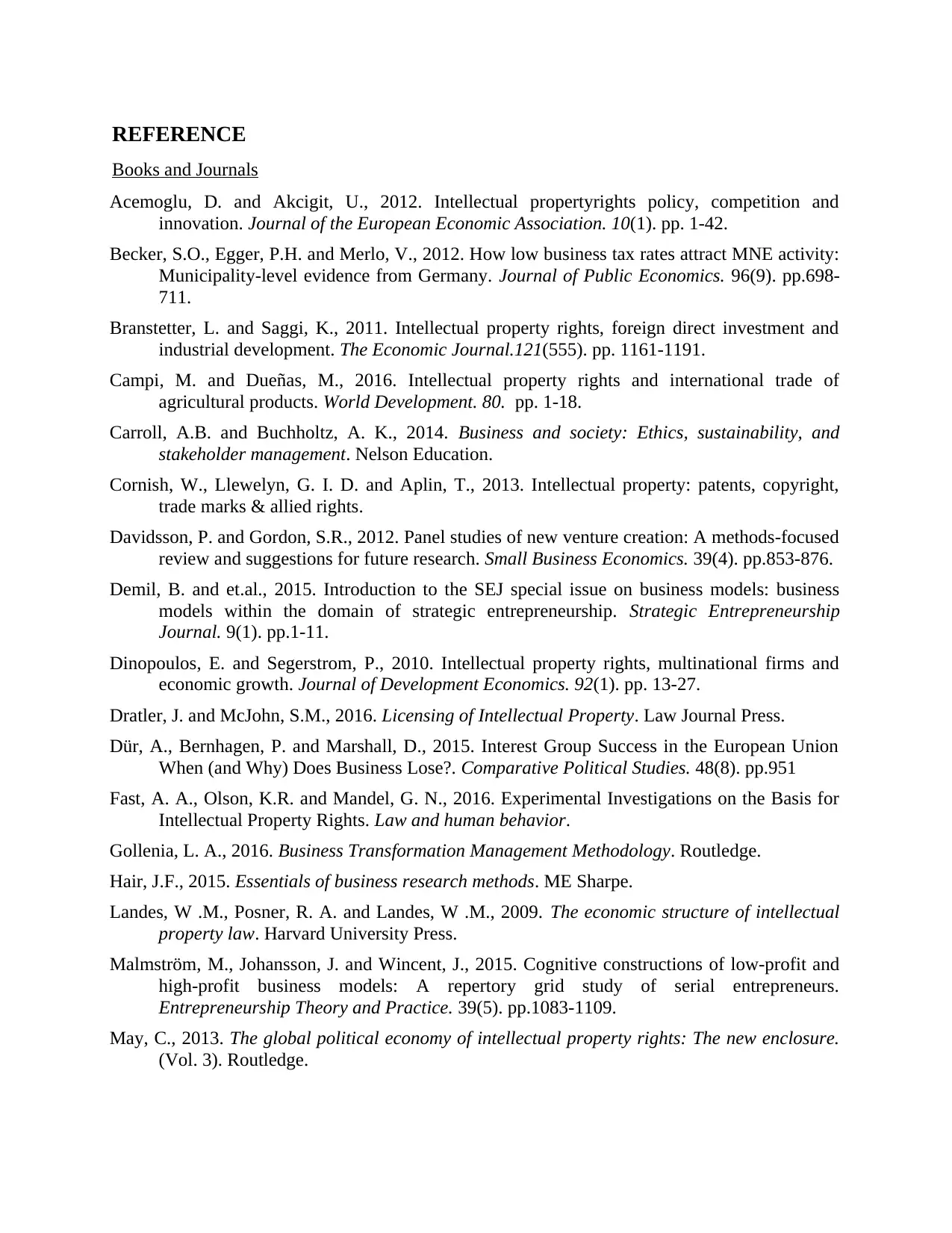
REFERENCE
Books and Journals
Acemoglu, D. and Akcigit, U., 2012. Intellectual propertyrights policy, competition and
innovation. Journal of the European Economic Association. 10(1). pp. 1-42.
Becker, S.O., Egger, P.H. and Merlo, V., 2012. How low business tax rates attract MNE activity:
Municipality-level evidence from Germany. Journal of Public Economics. 96(9). pp.698-
711.
Branstetter, L. and Saggi, K., 2011. Intellectual property rights, foreign direct investment and
industrial development. The Economic Journal.121(555). pp. 1161-1191.
Campi, M. and Dueñas, M., 2016. Intellectual property rights and international trade of
agricultural products. World Development. 80. pp. 1-18.
Carroll, A.B. and Buchholtz, A. K., 2014. Business and society: Ethics, sustainability, and
stakeholder management. Nelson Education.
Cornish, W., Llewelyn, G. I. D. and Aplin, T., 2013. Intellectual property: patents, copyright,
trade marks & allied rights.
Davidsson, P. and Gordon, S.R., 2012. Panel studies of new venture creation: A methods-focused
review and suggestions for future research. Small Business Economics. 39(4). pp.853-876.
Demil, B. and et.al., 2015. Introduction to the SEJ special issue on business models: business
models within the domain of strategic entrepreneurship. Strategic Entrepreneurship
Journal. 9(1). pp.1-11.
Dinopoulos, E. and Segerstrom, P., 2010. Intellectual property rights, multinational firms and
economic growth. Journal of Development Economics. 92(1). pp. 13-27.
Dratler, J. and McJohn, S.M., 2016. Licensing of Intellectual Property. Law Journal Press.
Dür, A., Bernhagen, P. and Marshall, D., 2015. Interest Group Success in the European Union
When (and Why) Does Business Lose?. Comparative Political Studies. 48(8). pp.951
Fast, A. A., Olson, K.R. and Mandel, G. N., 2016. Experimental Investigations on the Basis for
Intellectual Property Rights. Law and human behavior.
Gollenia, L. A., 2016. Business Transformation Management Methodology. Routledge.
Hair, J.F., 2015. Essentials of business research methods. ME Sharpe.
Landes, W .M., Posner, R. A. and Landes, W .M., 2009. The economic structure of intellectual
property law. Harvard University Press.
Malmström, M., Johansson, J. and Wincent, J., 2015. Cognitive constructions of low‐profit and
high‐profit business models: A repertory grid study of serial entrepreneurs.
Entrepreneurship Theory and Practice. 39(5). pp.1083-1109.
May, C., 2013. The global political economy of intellectual property rights: The new enclosure.
(Vol. 3). Routledge.
Books and Journals
Acemoglu, D. and Akcigit, U., 2012. Intellectual propertyrights policy, competition and
innovation. Journal of the European Economic Association. 10(1). pp. 1-42.
Becker, S.O., Egger, P.H. and Merlo, V., 2012. How low business tax rates attract MNE activity:
Municipality-level evidence from Germany. Journal of Public Economics. 96(9). pp.698-
711.
Branstetter, L. and Saggi, K., 2011. Intellectual property rights, foreign direct investment and
industrial development. The Economic Journal.121(555). pp. 1161-1191.
Campi, M. and Dueñas, M., 2016. Intellectual property rights and international trade of
agricultural products. World Development. 80. pp. 1-18.
Carroll, A.B. and Buchholtz, A. K., 2014. Business and society: Ethics, sustainability, and
stakeholder management. Nelson Education.
Cornish, W., Llewelyn, G. I. D. and Aplin, T., 2013. Intellectual property: patents, copyright,
trade marks & allied rights.
Davidsson, P. and Gordon, S.R., 2012. Panel studies of new venture creation: A methods-focused
review and suggestions for future research. Small Business Economics. 39(4). pp.853-876.
Demil, B. and et.al., 2015. Introduction to the SEJ special issue on business models: business
models within the domain of strategic entrepreneurship. Strategic Entrepreneurship
Journal. 9(1). pp.1-11.
Dinopoulos, E. and Segerstrom, P., 2010. Intellectual property rights, multinational firms and
economic growth. Journal of Development Economics. 92(1). pp. 13-27.
Dratler, J. and McJohn, S.M., 2016. Licensing of Intellectual Property. Law Journal Press.
Dür, A., Bernhagen, P. and Marshall, D., 2015. Interest Group Success in the European Union
When (and Why) Does Business Lose?. Comparative Political Studies. 48(8). pp.951
Fast, A. A., Olson, K.R. and Mandel, G. N., 2016. Experimental Investigations on the Basis for
Intellectual Property Rights. Law and human behavior.
Gollenia, L. A., 2016. Business Transformation Management Methodology. Routledge.
Hair, J.F., 2015. Essentials of business research methods. ME Sharpe.
Landes, W .M., Posner, R. A. and Landes, W .M., 2009. The economic structure of intellectual
property law. Harvard University Press.
Malmström, M., Johansson, J. and Wincent, J., 2015. Cognitive constructions of low‐profit and
high‐profit business models: A repertory grid study of serial entrepreneurs.
Entrepreneurship Theory and Practice. 39(5). pp.1083-1109.
May, C., 2013. The global political economy of intellectual property rights: The new enclosure.
(Vol. 3). Routledge.
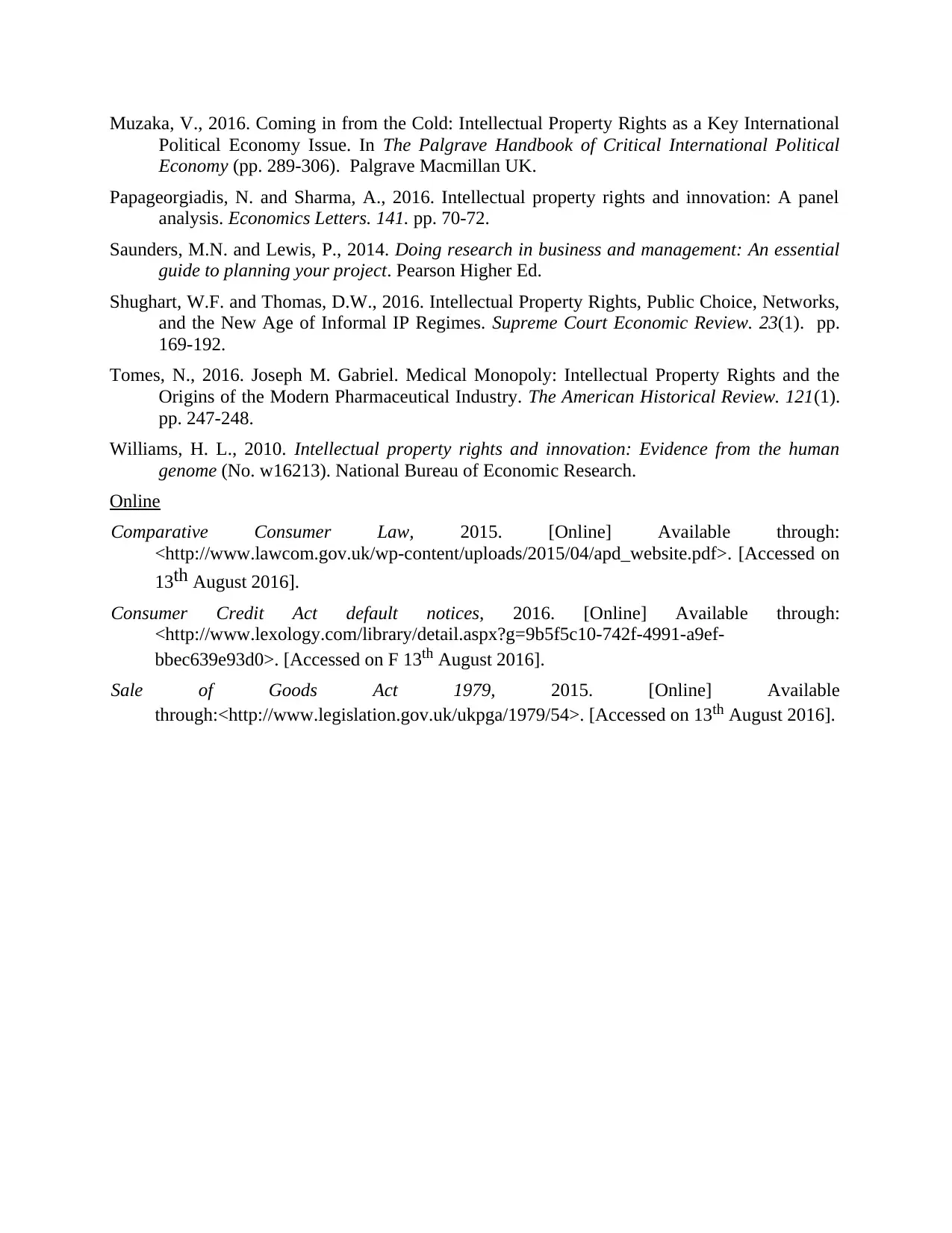
Muzaka, V., 2016. Coming in from the Cold: Intellectual Property Rights as a Key International
Political Economy Issue. In The Palgrave Handbook of Critical International Political
Economy (pp. 289-306). Palgrave Macmillan UK.
Papageorgiadis, N. and Sharma, A., 2016. Intellectual property rights and innovation: A panel
analysis. Economics Letters. 141. pp. 70-72.
Saunders, M.N. and Lewis, P., 2014. Doing research in business and management: An essential
guide to planning your project. Pearson Higher Ed.
Shughart, W.F. and Thomas, D.W., 2016. Intellectual Property Rights, Public Choice, Networks,
and the New Age of Informal IP Regimes. Supreme Court Economic Review. 23(1). pp.
169-192.
Tomes, N., 2016. Joseph M. Gabriel. Medical Monopoly: Intellectual Property Rights and the
Origins of the Modern Pharmaceutical Industry. The American Historical Review. 121(1).
pp. 247-248.
Williams, H. L., 2010. Intellectual property rights and innovation: Evidence from the human
genome (No. w16213). National Bureau of Economic Research.
Online
Comparative Consumer Law, 2015. [Online] Available through:
<http://www.lawcom.gov.uk/wp-content/uploads/2015/04/apd_website.pdf>. [Accessed on
13th August 2016].
Consumer Credit Act default notices, 2016. [Online] Available through:
<http://www.lexology.com/library/detail.aspx?g=9b5f5c10-742f-4991-a9ef-
bbec639e93d0>. [Accessed on F 13th August 2016].
Sale of Goods Act 1979, 2015. [Online] Available
through:<http://www.legislation.gov.uk/ukpga/1979/54>. [Accessed on 13th August 2016].
Political Economy Issue. In The Palgrave Handbook of Critical International Political
Economy (pp. 289-306). Palgrave Macmillan UK.
Papageorgiadis, N. and Sharma, A., 2016. Intellectual property rights and innovation: A panel
analysis. Economics Letters. 141. pp. 70-72.
Saunders, M.N. and Lewis, P., 2014. Doing research in business and management: An essential
guide to planning your project. Pearson Higher Ed.
Shughart, W.F. and Thomas, D.W., 2016. Intellectual Property Rights, Public Choice, Networks,
and the New Age of Informal IP Regimes. Supreme Court Economic Review. 23(1). pp.
169-192.
Tomes, N., 2016. Joseph M. Gabriel. Medical Monopoly: Intellectual Property Rights and the
Origins of the Modern Pharmaceutical Industry. The American Historical Review. 121(1).
pp. 247-248.
Williams, H. L., 2010. Intellectual property rights and innovation: Evidence from the human
genome (No. w16213). National Bureau of Economic Research.
Online
Comparative Consumer Law, 2015. [Online] Available through:
<http://www.lawcom.gov.uk/wp-content/uploads/2015/04/apd_website.pdf>. [Accessed on
13th August 2016].
Consumer Credit Act default notices, 2016. [Online] Available through:
<http://www.lexology.com/library/detail.aspx?g=9b5f5c10-742f-4991-a9ef-
bbec639e93d0>. [Accessed on F 13th August 2016].
Sale of Goods Act 1979, 2015. [Online] Available
through:<http://www.legislation.gov.uk/ukpga/1979/54>. [Accessed on 13th August 2016].
1 out of 13
Related Documents
Your All-in-One AI-Powered Toolkit for Academic Success.
+13062052269
info@desklib.com
Available 24*7 on WhatsApp / Email
![[object Object]](/_next/static/media/star-bottom.7253800d.svg)
Unlock your academic potential
© 2024 | Zucol Services PVT LTD | All rights reserved.





